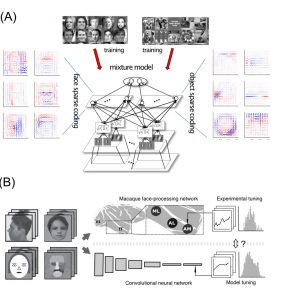Theoretical visual neuroscience and brain-inspired artificial intelligence
The visual system in primate has a remarkable capability. What are the underlying computational principles? What kind of novel artificial intelligence models does it inspire us? Our goal is to answer these questions using modern machine learning theories such as Bayesian statistical learning and deep learning.
Research topics
1. Computational models of the primate visual system
We pursue the principles underlying the neural visual system from the theoretical side. In particular, compared to the primary visual area (V1), computation in intermediate to higher visual areas is still a mystery. We formalize mathematical models of visual processing from learning-theoretic viewpoint and thereby explain visual cognitive functions such as visual feature representations of objects and faces and context-dependent visual recognition via feedback processing. We also collaborate with primate experimentalists to validate hypotheses that arise from our theories.
[1] Hosoya H, Hyvärinen A. A Hierarchical Statistical Model of Natural Images Explains Tuning Properties in V2. Journal of Neuroscience. 2015;35:10412–28.
[2] Haruo Hosoya, Aapo Hyvärinen. Learning Visual Spatial Pooling by Strong PCA Dimension Reduction. Neural Computation, 82:1-16, 2016.
[3] Haruo Hosoya, Aapo Hyvärinen. A mixture of sparse coding models explaining properties of face neurons related to holistic and parts-based processing. PLoS Computational Biology, 13(7): e1005667, 2017.
[4] Raman, R., Hosoya, H. Convolutional neural networks explain tuning properties of anterior, but not middle, face-processing areas in macaque inferotemporal cortex. Communications Biology, volume 3, Article number: 221 (2020).
2. Artificial intelligence inspired by the primate visual system
We develop new artificial intelligence (AI) models inspired by properties of the neural visual system that have been revealed by neurophysiological studies. In particular, higher visual areas show intriguing properties such as invariance and category-specificity. Although there must be reasons for the brain to adopt such representation strategy, current AI technology does not necessary make use of it. We design new AI models that combine state-of-the-art techniques (such as deep generative models) and newest knowledge from the neuroscience and thereby pursue performance improvement or innovative information processing systems.
[1] Hosoya, H. Group-based learning of disentangled representations with generalizability for novel contents. The International Joint Conference on Artificial Intelligence (IJCAI) , Aug, 2019.
Members and collaborators:
• Haruo Hosoya (ATR)
• Rajani Raman (KU Leuven)
• Aapo Hyvärinen (U Helsinki)
• Winrich Freiwald (Rockefeller U)

